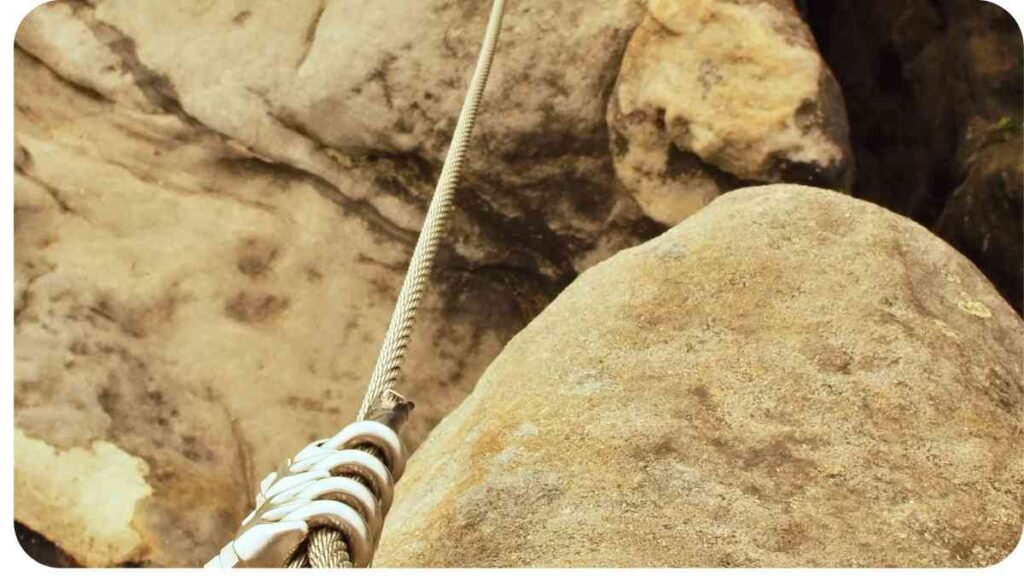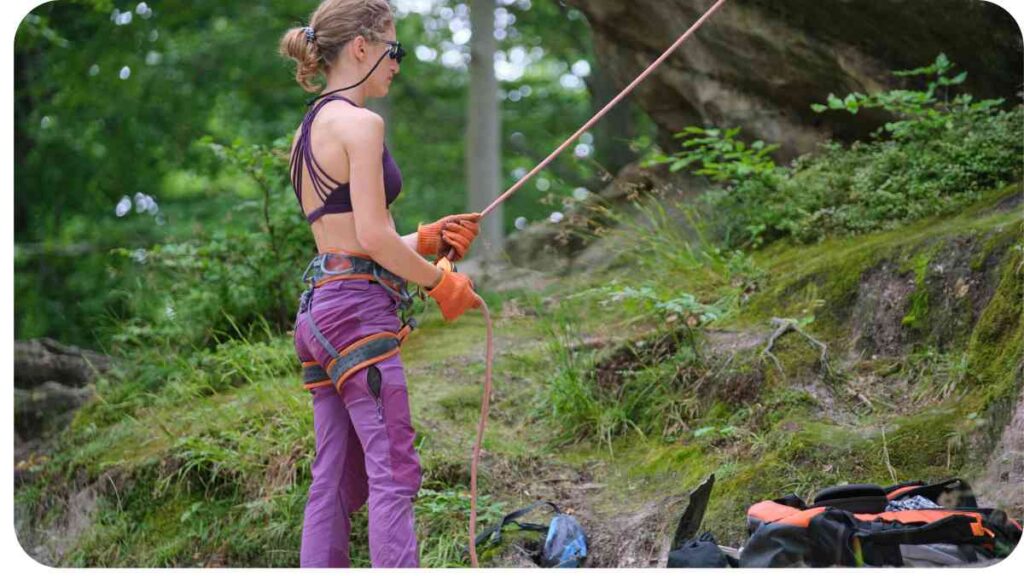Welcome to our comprehensive guide on navigating common belay device problems. As a climbing enthusiast, ensuring your safety during descents is paramount. Belay devices are essential tools that assist climbers in controlling rope tension, providing friction for a controlled descent, and preventing accidents. However, even with the most advanced devices, problems may arise.
In this article, we will delve into common issues that climbers face with belay devices and provide practical solutions to ensure your descent remains safe and secure. Through personal experiences and expert insights, we aim to equip you with the knowledge and skills necessary to overcome these challenges. So let’s dive in!
Key Takeaways
| Safe and Convenient Auto Belay Systems |
| Belaying Beginner’s Guide |
| Comprehensive Guide to Rappelling |
| Choosing the Right Belay Device |
| Importance of Using Dynamic Climbing Ropes |
| Consider Backup Measures for Added Safety |
| Effective Rope Slack Management |
| Regular Inspection and Replacement of Belay Devices |
| Enhancing Safety and Convenience with Auto Belay Systems |
| Proper Communication and Clear Signals in Belaying |
2. Understanding Belay Devices
Before we tackle common problems, it’s crucial to have a solid understanding of belay devices and their mechanics. Belay devices come in various designs, but they all serve the same purpose: assisting climbers in belaying their partners during ascents and descents.
Belay devices work by creating friction on the rope, allowing climbers to control the speed of descent or arrest a fall. The two main types of belay devices are assisted braking devices and manual braking devices.
- Assisted Braking Devices: These devices, such as the popular Petzl GriGri, utilize an internal locking mechanism that automatically engages and arrests the rope in the event of a sudden force or change in direction. They provide an additional level of safety and are particularly useful when belaying heavier climbers.
- Manual Braking Devices: Manual braking devices, like figure-8s or tube-style devices, rely on the belayer’s physical grip to control the friction on the rope. These devices require the belayer to maintain a firm hold and apply pressure to slow down or stop the rope’s movement.
Now that we have a basic understanding of belay devices, let’s explore the common problems climbers encounter.
When dealing with belay devices, it’s crucial to understand the importance of smooth operation. Check out these tips for smooth belay device operation to enhance your climbing experience.
3. Common Belay Device Problems
3.1. Rope Compatibility Issues
One of the most common issues climbers face is rope compatibility problems with their belay devices. Not all ropes work seamlessly with all belay devices, and using an incompatible combination can compromise safety. Table 1 below provides an overview of popular belay devices and their compatible rope diameters.
Table 1: Belay Devices and Compatible Rope Diameters
| Belay Device | Compatible Rope Diameters |
| Petzl GriGri | 8.5mm to 11mm |
| Black Diamond ATC | 8mm to 11mm |
| Mammut Smart | 8.7mm to 10.5mm |
| Edelrid Mega Jul | 7.8mm to 10.5mm |
To avoid rope compatibility issues, always check the manufacturer’s recommendations for your specific belay device and use a rope within the recommended diameter range. Using a rope thicker or thinner than specified can cause the rope to jam or slip, compromising your safety.
3.2. Improper Anchoring
When belaying, proper anchoring is vital to maintain control and prevent accidents. Failing to anchor yourself correctly can result in unexpected rope movement, loss of control, and potential injury.
Table 2: Anchoring Techniques for Belaying
| Situation | Anchoring Technique |
| Indoor Climbing Gym | Use provided top-rope anchors or follow gym-specific protocols for belaying. |
| Sport Climbing | Utilize suitable bolts, quickdraws, or anchors provided on the route. Ensure proper clipping techniques. |
| Traditional Climbing | Build solid anchor systems with reliable protection in conjunction with belay devices. |
| Multi-Pitch Climbing | Create comfortable, redundant anchor systems using slings, cordelettes, or bolts at each belay station. |
Understanding the appropriate anchoring techniques for different climbing situations is essential for maintaining control and ensuring a safe descent. Always follow industry recommendations and consult experienced climbers or guides when in doubt.
3.3. Rope
Compatibility Solutions
To address rope compatibility issues, there are several solutions you can implement. First, check the manufacturer’s specifications and recommendations for your belay device. They often provide a range of compatible rope diameters. Ensure that the diameter of your rope falls within this range to ensure optimal performance and safety.
If you find that your rope is outside the recommended range, consider purchasing a different belay device that accommodates your rope diameter. Table 3 below showcases some belay devices and their compatible rope diameters to help you make an informed decision.
Altitude sickness can affect climbers during descents. Learn about the causes, symptoms, and remedies for altitude sickness in climbing to ensure a safe journey on the mountains.
Table 3: Belay Devices and Compatible Rope Diameters
| Belay Device | Compatible Rope Diameters |
| Petzl GriGri+ | 8.5mm to 11mm |
| Black Diamond ATC-Guide | 8mm to 11mm |
| Edelrid Mega Jul | 7.8mm to 10.5mm |
| Trango Vergo | 8.9mm to 10.7mm |
Additionally, consult with experienced climbers or seek advice from your local climbing gear store. They can provide recommendations based on their expertise and firsthand experience with different rope and belay device combinations.
3.4. Slippage and Chafing
Slippage and chafing are problems that can occur during belaying if the rope isn’t properly managed. When the rope slips through the belay device too quickly, it can lead to an uncontrolled descent or even cause burns on the belayer’s hands.
To prevent slippage and chafing, maintain a firm grip on the rope while belaying. Applying moderate pressure against the rope can help control the speed of descent and minimize slippage. Additionally, regularly inspect the condition of your belay device and rope. Worn-out or damaged equipment can contribute to slippage and chafing. If you notice any signs of wear, consider replacing the equipment to ensure your safety.
Table 4 presents a few techniques and tips to help you prevent slippage and chafing while using different belay devices.
A comfortable climbing harness is essential for safety. Discover how to address discomfort issues and find fixes for your climbing harness to optimize your belaying experience.
Table 4: Techniques to Prevent Slippage and Chafing
| Belay Device | Technique |
| Petzl GriGri+ | Keep a firm grip on the brake rope during descent. Use controlled, smooth hand movements. |
| Black Diamond ATC-Guide | Apply moderate pressure with your brake hand to control the rope’s speed. |
| Edelrid Mega Jul | Use the thumb-loop technique to control the rope’s descent speed. Regularly check for rope wear. |
| Trango Vergo | Maintain a firm grip on the rope and regulate the speed with the lever arm. |
By following these techniques and selecting the appropriate belay device, you can mitigate slippage and chafing issues, ensuring a smooth and safe descent.
Now that we’ve covered some common problems related to belay devices, let’s explore troubleshooting strategies in the next section.
4. Troubleshooting Belay Device Problems
When faced with belay device problems, it’s essential to remain calm, assess the situation, and apply appropriate troubleshooting techniques. Let’s examine common issues and their respective solutions.
4.1. Rope Compatibility Solutions
If you encounter a rope compatibility issue while climbing, there are a few steps you can take to address the problem:
- First, check your belay device’s instructions and ensure that you’re using a rope within the recommended diameter range.
- If your rope is too thick, try using a device specifically designed for thicker ropes.
- If your rope is too thin, consider using an additional backup knot, such as a double fisherman’s knot, to prevent slippage.
- If possible, you can also borrow a compatible rope from a fellow climber or climbing gym.
Remember, compromising on rope compatibility can lead to decreased performance and potential safety hazards. Always prioritize using the appropriate equipment for your belay device.
Rope wear can jeopardize your safety during descent. Explore the causes and effective remedies for rope fraying to maintain the integrity of your climbing gear.
4.2. Proper Anchoring Techniques

If you’re experiencing issues with anchoring while belaying, here are some troubleshooting tips:
- Double-check if your anchor system is constructed properly using appropriate gear and techniques for the specific climbing scenario. Refer to Table 2 for recommended anchoring techniques.
- Ensure all connections are secure and tested prior to belaying.
- Communicate with your climbing partner to ensure they are comfortable and confident in the anchor system.
If you’re unsure about anchoring techniques or encounter specific challenges, it’s best to consult experienced climbers or seek professional guidance. They can provide valuable insights and assistance in troubleshooting anchoring problems.
4.3. Handling Rope Jamming Situations
Rope jamming can be a frustrating problem, but with proper techniques, you can effectively manage these situations:
- Start by assessing the condition of the rope and determining the cause of the jam. Common causes include knots, twists, and improper rope management.
- Carefully untangle any knots or twists in the rope by following the correct procedures. Avoid yanking or pulling forcefully, as this can worsen the situation.
- If the rope is severely jammed and cannot be easily untangled, consider using a “belay escape” technique. This technique involves momentarily releasing tension on the rope while maintaining control of the climber using a backup belay device or friction hitch. Seek guidance from experienced climbers or instructors to learn proper belay escape techniques.
Table 5 provides an overview of troubleshooting techniques for handling rope jamming situations with different belay devices.
Dealing with rope drag troubles? Reduce resistance during climbing by following these valuable tips for reducing rope drag. Enhance your climbing efficiency and safety with these insights.
Table 5: Troubleshooting Rope Jamming Situations
| Belay Device | Troubleshooting Technique |
| Petzl GriGri+ | Gently manipulate the rope and untangle any knots or twists. Release tension on the rope if necessary to alleviate pressure. |
| Black Diamond ATC-Guide | Carefully reverse the direction of the rope through the device to free any entangled sections. |
| Edelrid Mega Jul | Gradually release tension on the rope and systematically work through the jammed area. |
| Trango Vergo | Employ a belay escape technique if the rope jam cannot be resolved by manipulation alone. |
Remember, when dealing with rope jamming, patience and a calm mindset are crucial. Rushing or panicking can lead to further entanglement or unsafe practices. Take your time and carefully address the issue to ensure a safe climbing experience.
4.4. Preventing Slippage and Chafing
To prevent slippage and chafing during belaying, consider the following troubleshooting techniques:
- Maintain a firm grip on the rope while belaying, focusing on proper hand positioning and using controlled movements.
- Ensure that your belay device is clean and free from dirt, grime, or excess rope fibers. Regularly inspect and clean your equipment to prevent unnecessary friction.
- If you experience excessive rope slippage, consider using gloves designed for climbing to protect your hands.
Furthermore, Table 6 presents additional troubleshooting tips to prevent slippage and chafing while using specific belay devices.
Table 6: Troubleshooting Slippage and Chafing
| Belay Device | Troubleshooting Technique |
| Petzl GriGri+ | Practice smooth and controlled hand movements, applying appropriate pressure to maintain control. |
| Black Diamond ATC-Guide | Ensure your brake hand applies sufficient pressure to regulate the rope’s speed. Consider using gloves for added grip. |
| Edelrid Mega Jul | Explore different hand positioning techniques, such as the thumb-loop method, to enhance control and prevent slippage. |
| Trango Vergo | Adjust the lever arm tension to achieve the desired friction and control. Regularly inspect the device for any wear or damage. |
By implementing these troubleshooting techniques and tips, you can effectively address common belay device problems and promote a safer climbing experience for both you and your partner.
In the next section, we will cover some best practices for belaying to further enhance your climbing skills and safety.
5. Best Practices for Belaying

To ensure a safe and enjoyable climbing experience, it’s crucial to follow these best practices for belaying:
- Check your equipment: Before each climb, thoroughly inspect your belay device, rope, carabiners, and harness to ensure they are in good working condition and free from any defects or damage. Replace any worn-out or damaged equipment.
- Communicate with your climbing partner: Establish clear communication with your climbing partner and agree on signals and commands. Verify that you both understand and are comfortable with the belaying process.
- Anchor properly: Always anchor yourself securely when belaying. Utilize appropriate and reliable anchoring techniques based on the specific climbing scenario (as discussed in Table 2). Ensure your anchor system is well-constructed, redundant, and properly tested.
- Maintain a proper belay stance: Stand upright, with your feet shoulder-width apart and knees slightly bent. Keep your weight centered and maintain good balance. Avoid leaning back excessively, as this can compromise control.
- Stay attentive: Pay close attention to your climbing partner at all times. Be vigilant and responsive, ready to take action when needed. Avoid distractions and prioritize the task at hand.
- Provide a controlled descent: Regulate the speed of descent by applying appropriate pressure and maintaining a firm grip on the rope. Avoid sudden movements or releasing tension too quickly. Communicate with your partner to ensure a comfortable and controlled descent.
- Practice good rope management: Keep the rope properly organized and prevent it from tangling or dragging on the ground. Avoid stepping or standing on the rope, as it can weaken or damage it.
- Communicate effectively: Use clear and concise verbal commands or signals to communicate with your climbing partner. Confirm understanding before proceeding with any actions.
- Maintain focus and concentration: Belaying requires concentration and focus. Avoid distractions, such as chatting with others or using electronic devices, while belaying.
- Continuously improve your skills: Regularly practice and seek guidance from experienced climbers or instructors to improve your belaying techniques. Stay updated with the latest safety guidelines and industry best practices.
By adhering to these best practices, you can enhance your belaying skills and contribute to a safer climbing environment for everyone involved.
6. Conclusion
Belaying is a vital skill in climbing, and being aware of common belay device problems is crucial for maintaining safety. By understanding rope compatibility, proper anchoring techniques, and troubleshooting strategies, you can navigate these challenges effectively.
Remember to prioritize safety by using compatible equipment, practicing proper anchoring, and employing troubleshooting techniques when problems arise. Additionally, following best practices for belaying ensures a secure and enjoyable climbing experience.
Now equipped with the knowledge and skills to navigate common belay device problems, go forth and embrace the adventures that climbing has to offer. Stay safe, trust your gear, and continue learning and improving your skills. Happy climbing!
Further Reading
Here are some additional resources you can explore to learn more about belaying and related topics:
- A Closer Look at the Auto Belay System: Combining Safety and Convenience: This article provides insights into auto belay systems, their benefits, and how they contribute to safety and convenience in climbing.
- Belaying Beginner’s Guide: If you’re new to belaying, this guide offers comprehensive information on the basics of belaying, including techniques, equipment, communication, and safety measures.
- How to Rappel: A Comprehensive Guide: This blog post provides a step-by-step guide on how to rappel safely and efficiently, covering equipment, techniques, and best practices.
These resources offer deeper insights and practical advice to expand your knowledge and skills in belaying, auto belay systems, and rappelling.
FAQs
Here are some frequently asked questions related to belaying:
How do I choose the right belay device?
The choice of a belay device depends on several factors, including rope diameter compatibility, personal preference, and climbing style. Consider factors like handling, weight, and assisted braking mechanisms when selecting your belay device.
Can I use any rope for belaying?
It is important to use a dynamic climbing rope that meets the necessary safety standards for belaying. Static ropes or ropes not designed for climbing should not be used for belaying.
Do I need a backup while belaying?
A backup or additional safety measure, such as a friction hitch or backup belay device, can be beneficial in certain situations to provide an extra level of security. However, proper technique and attentiveness are essential to ensure safe belaying without relying solely on a backup.
How do I manage rope slack while belaying?
Managing rope slack effectively involves precise hand movements and constant vigilance. Learn techniques such as giving slack, taking in slack, and arcing to ensure a controlled climbing experience and minimize unnecessary slack.
How often should I replace my belay device?
Regularly inspect your belay device for wear and tear. Replace it if you notice signs of significant wear, corrosion, or damage that may compromise its functionality and safety. Refer to the manufacturer’s guidelines for specific recommendations on the lifespan of your belay device.

Welcome to my blog! I’m Hellen James, and I’m incredibly passionate about rock climbing, bouldering, ice climbing, and mountaineering. Join me as I embark on thrilling adventures, conquer vertical challenges, and share my experiences and insights with fellow outdoor enthusiasts.


